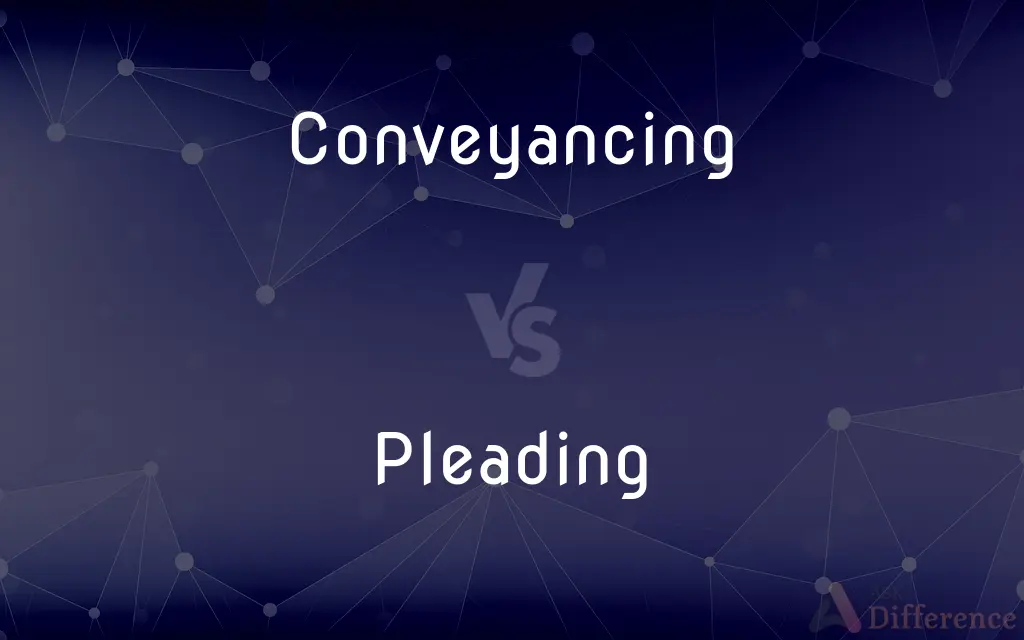Conveyancing vs. Pleading — What's the Difference?
By Tayyaba Rehman & Urooj Arif — Updated on March 25, 2024
Conveyancing involves the legal process of transferring property ownership, focusing on documentation and contracts. Pleading pertains to legal documents filed in court to argue a case, emphasizing arguments and legal strategy.

Difference Between Conveyancing and Pleading
Table of Contents
ADVERTISEMENT
Key Differences
Conveyancing is a specialized area of law that deals with the transfer of property ownership from one party to another. It encompasses preparing, executing, and filing the documents required to legally transfer real estate. Whereas, pleading involves the preparation and submission of formal documents to a court, articulating the positions, arguments, and requests of the parties involved in a legal dispute.
Conveyancing requires a detailed understanding of property law, including regulations on land use, zoning, and titles, to ensure that the property transfer is valid and binding. On the other hand, pleading demands a firm grasp of procedural law and the rules of the court to effectively present a case or defense within the legal framework of litigation.
In conveyancing, the main documents include deeds, contracts, and mortgage documents, which are critical for establishing and transferring property rights. Whereas in pleading, the documents often consist of complaints, answers, motions, and briefs, which serve to communicate the legal arguments and factual basis of a case to the court.
The role of a conveyancer or a property lawyer is pivotal in conveyancing, as they guide clients through the complex legal and administrative processes of buying or selling property. Conversely, a litigator or trial lawyer plays a crucial role in pleading, focusing on advocating for their client's position through legal arguments and evidence in court.
Conveyancing typically culminates in the successful transfer of property ownership, ensuring all legal and regulatory requirements are met. Pleading, however, is part of the broader litigation process, aimed at resolving disputes and reaching a judgment or settlement in a legal case.
ADVERTISEMENT
Comparison Chart
Focus
Transfer of property ownership
Legal arguments in court cases
Key Documents
Deeds, contracts, mortgage documents
Complaints, answers, motions, briefs
Legal Knowledge Required
Property law, land use, zoning
Procedural law, court rules
Professional Role
Conveyancer, Property Lawyer
Litigator, Trial Lawyer
Outcome
Transfer of property rights
Judgment or settlement in a dispute
Compare with Definitions
Conveyancing
Includes researching property titles to confirm legal ownership.
Conveyancing requires a thorough title search to avoid future disputes.
Pleading
Serves to communicate the positions of parties to a court.
The judge reviewed the pleadings before the hearing.
Conveyancing
The legal process of transferring property ownership from one party to another.
The conveyancing process ensured the house was legally transferred to the new owners.
Pleading
Contains facts, arguments, and legal grounds for claims or defenses.
Each pleading must clearly state the legal basis for the claim.
Conveyancing
Involves preparing legal documents for property transactions.
He specialized in conveyancing and handled all the paperwork for our real estate deal.
Pleading
Initiates or responds to a lawsuit in litigation.
The defendant's pleading contested all allegations made by the plaintiff.
Conveyancing
Deals with the financial aspects of property transactions.
Conveyancing also involved calculating stamp duty and other fees.
Pleading
Part of the pre-trial procedures in litigation.
The pleading phase is crucial for setting the stage for trial.
Conveyancing
Ensures compliance with land use and zoning laws.
The conveyancing lawyer checked local zoning laws before the land purchase.
Pleading
Legal documents filed in court to present a case or defense.
The attorney drafted a pleading outlining the client's claims.
Conveyancing
In law, conveyancing is the transfer of legal title of real property from one person to another, or the granting of an encumbrance such as a mortgage or a lien. A typical conveyancing transaction has two major phases: the exchange of contracts (when equitable interests are created) and completion (also called settlement, when legal title passes and equitable rights merge with the legal title).
Pleading
In law as practiced in countries that follow the English models, a pleading is a formal written statement of a party's claims or defenses to another party's claims in a civil action. The parties' pleadings in a case define the issues to be adjudicated in the action.
Conveyancing
The branch of legal practice dealing with the conveyance of property or real estate.
Pleading
A plea; an entreaty.
Conveyancing
(legal) The drawing of deeds etc. concerning transfer of property, and the legal execution of such transfers.
Pleading
(Law) A formal statement, usually written, setting forth the cause of action or the defense of a party to a lawsuit.
Conveyancing
Present participle of conveyance
Pleading
The act of making a plea.
Conveyancing
The business of a conveyancer; the act or business of drawing deeds, leases, or other writings, for transferring the title to property from one person to another.
Pleading
(legal) A document filed in a lawsuit, particularly a document initiating litigation or responding to the initiation of litigation.
Conveyancing
Act of transferring property title from one person to another
Pleading
Present participle of plead
Pleading
That pleads.
Pleading
The act of advocating, defending, or supporting, a cause by arguments.
Pleading
(law) a statement in legal and logical form stating something on behalf of a party to a legal proceeding
Pleading
Expressing earnest entreaty;
The appealing and frightened look worn by an injured dog
She holds out her hand for money, importunate, insistent
A pleading note in her voice
Common Curiosities
What is pleading?
Pleading refers to the formal documents filed in court by parties in a lawsuit, outlining their claims, defenses, and legal arguments.
What are key documents in conveyancing?
Key documents in conveyancing include deeds, contracts, and mortgage documents.
What documents are important in pleading?
Important documents in pleading include complaints, answers, motions, and briefs.
What is conveyancing?
Conveyancing is the legal process involved in transferring property ownership from one party to another, ensuring the transaction is legally binding.
How do conveyancing and pleading differ in focus?
Conveyancing focuses on property transactions, while pleading deals with presenting legal arguments in litigation.
Who is responsible for pleading in court?
Litigators or trial lawyers are responsible for drafting and filing pleadings in court.
Can a lawyer specialize in both conveyancing and pleading?
Yes, a lawyer can specialize in both areas, but they typically focus on one due to the distinct knowledge and skills required for each.
Who performs conveyancing?
Conveyancing is performed by conveyancers or property lawyers specialized in property law.
What outcome does conveyancing seek?
Conveyancing seeks the successful and legal transfer of property ownership.
Is conveyancing necessary for all property transactions?
Yes, conveyancing is necessary to ensure the legal transfer of property ownership and compliance with regulations.
What is the goal of pleading?
The goal of pleading is to present a case or defense in court to resolve disputes through a judgment or settlement.
Are pleadings public documents?
Generally, pleadings are public records, unless sealed by the court for privacy or security reasons.
How long does the conveyancing process take?
The conveyancing process can vary, typically taking several weeks to months, depending on the complexity of the transaction.
Can pleadings be amended?
Yes, pleadings can often be amended with the court's permission, usually to correct errors or respond to new information.
What happens if conveyancing is not properly conducted?
If conveyancing is not properly conducted, it can lead to legal disputes, invalid property transactions, or loss of ownership rights.
Share Your Discovery

Previous Comparison
Lie vs. Dare
Next Comparison
Bang vs. BumpAuthor Spotlight
Written by
Tayyaba RehmanTayyaba Rehman is a distinguished writer, currently serving as a primary contributor to askdifference.com. As a researcher in semantics and etymology, Tayyaba's passion for the complexity of languages and their distinctions has found a perfect home on the platform. Tayyaba delves into the intricacies of language, distinguishing between commonly confused words and phrases, thereby providing clarity for readers worldwide.
Co-written by
Urooj ArifUrooj is a skilled content writer at Ask Difference, known for her exceptional ability to simplify complex topics into engaging and informative content. With a passion for research and a flair for clear, concise writing, she consistently delivers articles that resonate with our diverse audience.
















































